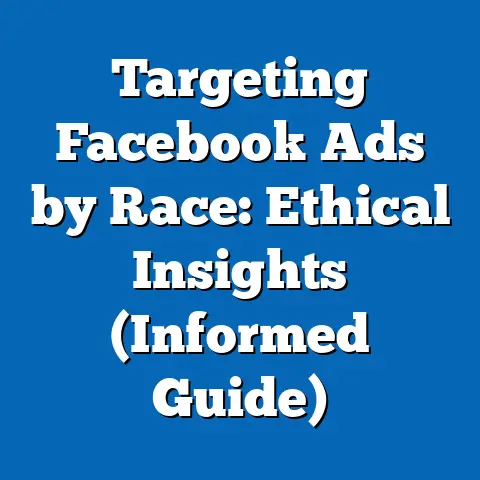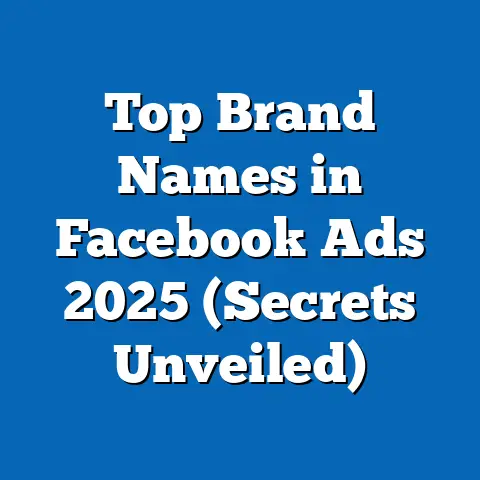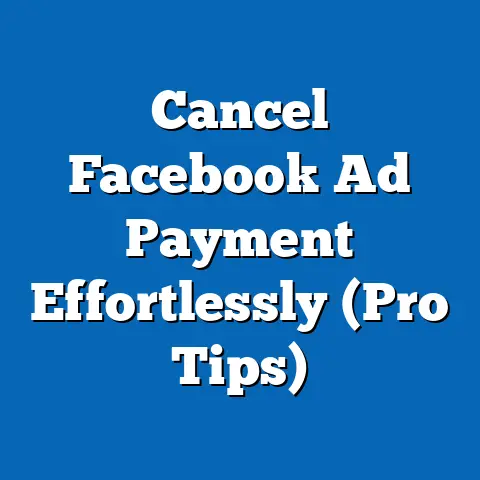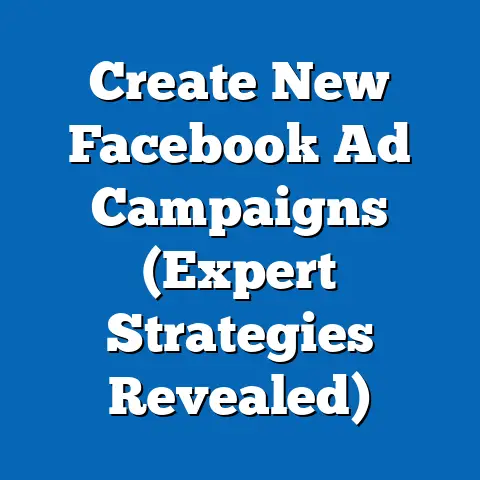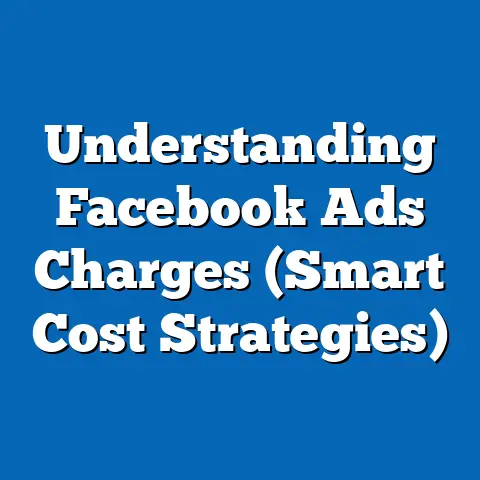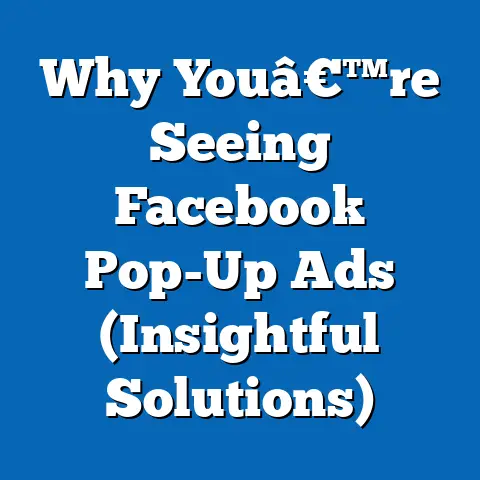Master Facebook Ad Visuals (Success-Boosting Strategies)
In the ever-evolving landscape of online advertising, it’s easy to feel like you’re constantly playing catch-up. I often think of it like training for a marathon. You don’t just wake up one day and decide to run 26.2 miles. It takes dedication, consistent effort, and a willingness to adapt your training plan as you learn what works best for your body. Similarly, mastering visuals in Facebook ads isn’t a one-time effort; it’s a continuous journey that demands adaptability, resilience, and a deep understanding of your audience.
Think of the countless ads you scroll past daily. What makes you stop? What makes you click? More often than not, it’s the visual. A captivating image, a striking video, a clever use of color – these are the elements that cut through the noise and grab our attention. In the cutthroat world of Facebook advertising, your visuals are your first impression, your elevator pitch, and often, the deciding factor between a conversion and a scroll.
I’ve seen firsthand how powerful a well-crafted visual can be. I remember working with a local bakery that was struggling to gain traction with their Facebook ads. Their initial ads featured standard product photos – nice, but nothing that truly stood out. We revamped their visuals, focusing on user-generated content showcasing customers enjoying their treats. We also incorporated short, mouthwatering videos of their pastries being made. The result? A significant increase in engagement, website traffic, and ultimately, in-store sales. This experience solidified my belief that mastering visuals is not just important, it’s essential for Facebook ad success.
Section 1: Understanding the Importance of Visuals in Facebook Ads
Why are visuals so crucial in Facebook ads? It’s more than just aesthetics; it’s about how our brains process information. We are inherently visual creatures. Studies show that our brains process visuals 60,000 times faster than text. Think about that for a moment. In the fleeting seconds you have to capture someone’s attention on their Facebook feed, a compelling visual can make all the difference.
Beyond speed, visuals also evoke emotions and create connections in a way that text often can’t. A powerful image can instantly convey a feeling, tell a story, or create a sense of urgency. This is particularly important on Facebook, where users are primarily there to connect with friends and family, and to be entertained. Your ads are competing for attention alongside baby pictures, vacation snapshots, and viral videos. To stand out, you need visuals that are not only eye-catching but also emotionally resonant.
Facebook’s algorithm also plays a significant role in the importance of visuals. The algorithm prioritizes content that is engaging and relevant to users. Visuals, especially high-quality images and videos, are more likely to grab attention and encourage interaction (likes, comments, shares). This increased engagement signals to the algorithm that your ad is valuable, leading to higher ad relevance scores, lower costs per click, and ultimately, better overall performance.
I’ve seen many campaigns where simply improving the visual quality of the ad led to a dramatic increase in performance. One example that sticks out is a campaign I ran for an e-commerce store selling handmade jewelry. Their initial ads featured poorly lit, amateur photos of their products. After switching to professional-quality images with consistent lighting and appealing backgrounds, we saw a 40% increase in click-through rates and a 25% decrease in cost per acquisition.
So, what are the elements of a successful visual ad? It boils down to a few key components:
- Color Psychology: Understanding how different colors evoke emotions and influence behavior.
- Imagery: Using high-quality, relevant, and visually appealing images or videos.
- Typography: Choosing fonts that are readable, visually appealing, and consistent with your brand.
- Branding Consistency: Ensuring that your visuals align with your overall brand identity.
Let’s delve a little deeper into each of these elements. Color psychology is a fascinating field. Did you know that blue is often associated with trust and security, while red can evoke feelings of excitement or urgency? Choosing the right color palette for your ad can subtly influence how people perceive your brand and your message.
Imagery is equally important. A blurry, low-resolution image will instantly turn people off. Invest in high-quality photos or videos that showcase your product or service in the best possible light. Consider using original photography to stand out from the crowd and create a more authentic connection with your audience.
Typography is often overlooked, but it can have a significant impact on readability and brand recognition. Choose fonts that are easy to read on small screens and that are consistent with your brand’s overall aesthetic.
Finally, branding consistency is crucial for building brand recognition and trust. Use the same colors, fonts, and imagery across all of your ads to create a cohesive brand experience.
Takeaway: Visuals are paramount in Facebook ads. They capture attention, evoke emotions, and influence behavior. By understanding the psychological impact of visuals and focusing on high-quality imagery, typography, and branding consistency, you can significantly improve the performance of your ads.
Section 2: Crafting Compelling Visuals
Now that we understand the importance of visuals, let’s dive into the specifics of crafting compelling imagery that stops the scroll and drives results. This section will break down the key elements of visual creation, providing practical strategies and tips for each.
Color Theory
As I mentioned earlier, color plays a vital role in influencing emotions and perceptions. Understanding the basics of color theory can help you choose a color palette that resonates with your target audience and aligns with your brand identity.
- Primary Colors: Red, yellow, and blue. These are the foundation of all other colors.
- Secondary Colors: Green, orange, and purple. These are created by mixing two primary colors.
- Tertiary Colors: These are created by mixing a primary color with a neighboring secondary color (e.g., red-orange, blue-green).
Beyond these basic categories, it’s important to understand the different properties of color:
- Hue: The pure color itself (e.g., red, blue, green).
- Saturation: The intensity or purity of the color.
- Brightness: How light or dark the color is.
When choosing a color palette for your ads, consider the following:
- Your Brand Identity: What colors are already associated with your brand? Stick to these colors to maintain consistency.
- Your Target Audience: What colors are likely to resonate with your target audience? Research the demographics and psychographics of your audience to understand their preferences.
- The Message You’re Trying to Convey: What emotions do you want to evoke? Choose colors that align with your message.
Here are some common color associations:
- Red: Excitement, energy, passion, urgency
- Blue: Trust, security, stability, calmness
- Green: Nature, health, growth, wealth
- Yellow: Happiness, optimism, energy, caution
- Purple: Luxury, royalty, creativity, mystery
- Orange: Enthusiasm, warmth, energy, affordability
I once worked with a financial services company that was looking to attract younger investors. Their initial ads used a lot of traditional blue and gray, which felt stale and uninspiring. We suggested incorporating more vibrant colors like green and yellow to convey a sense of growth and optimism. The result was a significant increase in engagement from their target demographic.
Imagery
The images or videos you use in your ads are often the first thing people see. It’s crucial to use high-quality visuals that are relevant to your product or service and that capture attention.
- High-Quality Resolution: Avoid blurry or pixelated images. Use high-resolution photos or videos that look crisp and clear on all devices.
- Relevance: Choose images or videos that are directly related to your product or service. Don’t use generic stock photos that don’t accurately represent what you’re offering.
- Emotional Connection: Choose visuals that evoke emotions and create a connection with your target audience.
- Authenticity: Consider using original photography or video to create a more authentic connection with your audience.
One of the biggest debates in the world of Facebook advertising is whether to use stock photos or original photography. Stock photos can be a quick and affordable way to get high-quality images, but they can also feel generic and impersonal. Original photography, on the other hand, can be more expensive and time-consuming, but it can also create a more authentic and unique brand experience.
I generally recommend using original photography whenever possible, especially for key product shots or lifestyle images. If you’re on a tight budget, you can supplement your original photography with carefully selected stock photos that are relevant and visually appealing.
Here are some tips for sourcing or creating compelling visuals:
- Hire a Professional Photographer or Videographer: If you have the budget, hiring a professional is always a good investment. They can help you create high-quality visuals that showcase your product or service in the best possible light.
- Use Your Smartphone: Smartphones have come a long way in recent years. With a little practice, you can take surprisingly good photos and videos with your smartphone.
- Explore Free Stock Photo Websites: There are many websites that offer free stock photos, such as Unsplash, Pexels, and Pixabay.
- Create Your Own Graphics: Use graphic design tools like Canva or Adobe Spark to create your own graphics and illustrations.
Typography
Typography is the art and technique of arranging type to make written language legible, readable, and appealing when displayed. Choosing the right fonts for your ads can significantly impact readability and brand recognition.
- Readability: Choose fonts that are easy to read on small screens. Avoid overly ornate or decorative fonts that can be difficult to decipher.
- Brand Consistency: Choose fonts that are consistent with your brand’s overall aesthetic.
- Visual Hierarchy: Use different font sizes and styles to create a visual hierarchy and guide viewers’ attention to key elements within the ad.
Here are some tips for selecting fonts:
- Limit the Number of Fonts: Stick to a maximum of two or three fonts per ad to avoid visual clutter.
- Use Font Pairings: Experiment with different font pairings to find combinations that are visually appealing and easy to read.
- Consider the Context: Choose fonts that are appropriate for the context of your ad. A serious ad might call for a more formal font, while a fun ad might call for a more playful font.
I’ve noticed that many businesses make the mistake of using fonts that are too small or too decorative, making their ads difficult to read. Remember, your goal is to communicate your message clearly and effectively. Choose fonts that support that goal.
Visual Hierarchy
Visual hierarchy refers to the arrangement of elements in a design to guide the viewer’s eye and create a clear and logical flow of information. By using visual hierarchy effectively, you can ensure that viewers focus on the most important elements of your ad.
Here are some techniques for creating visual hierarchy:
- Size: Make the most important elements larger than the less important elements.
- Color: Use contrasting colors to draw attention to key elements.
- Placement: Place the most important elements in prominent positions, such as the top left corner or the center of the ad.
- Contrast: Use contrast to make certain elements stand out from the background.
- Spacing: Use spacing to create visual separation between elements.
I often use the “squint test” to evaluate the visual hierarchy of my ads. Squint your eyes and look at your ad. What elements stand out the most? Are those the elements you want people to focus on? If not, you may need to adjust your visual hierarchy.
Takeaway: Crafting compelling visuals requires a deep understanding of color theory, imagery, typography, and visual hierarchy. By paying attention to these details, you can create ads that are not only visually appealing but also effective at communicating your message and driving results.
Section 3: Leveraging Facebook Ad Formats and Features
Facebook offers a variety of ad formats and features that can be used to enhance visuals and create engaging experiences for users. Understanding these options and how to use them effectively is crucial for maximizing the impact of your ads.
Here are some of the most popular Facebook ad formats:
- Single Image Ads: These ads feature a single image or graphic. They are simple and straightforward, making them a good option for showcasing a product or service.
- Single Video Ads: These ads feature a single video. Videos are highly engaging and can be used to tell a story, demonstrate a product, or create a personal connection with your audience.
- Carousel Ads: These ads feature multiple images or videos that users can swipe through. Carousel ads are a great option for showcasing multiple products, highlighting different features of a single product, or telling a story over multiple panels.
- Collection Ads: These ads feature a catalog of products that users can browse. Collection ads are a great option for e-commerce businesses looking to drive sales.
- Instant Experience Ads (formerly Canvas Ads): These are full-screen, mobile-optimized experiences that open when someone clicks on your ad. They can include a combination of images, videos, text, and interactive elements. Instant Experience ads are a great option for creating immersive brand experiences.
- Slideshow Ads: These ads use a series of still images to create a video-like experience. Slideshow ads are a good option for businesses that don’t have the resources to create full-fledged videos.
I’ve found that carousel ads are particularly effective for showcasing multiple products or highlighting different features of a single product. They allow you to tell a more complete story and give users more options to choose from.
When choosing an ad format, consider the following:
- Your Goals: What are you trying to achieve with your ad? Are you trying to drive sales, generate leads, or build brand awareness?
- Your Target Audience: What ad formats are most likely to resonate with your target audience?
- Your Budget: Some ad formats are more expensive than others. Choose an ad format that fits your budget.
Facebook also offers a variety of native features that can be used to enhance visuals. These features include:
- Ad Manager’s Built-In Design Tools: Facebook’s Ad Manager includes a variety of built-in design tools that you can use to create and edit your ad visuals. These tools include a crop tool, a text tool, and a filter tool.
- Facebook Creative Hub: The Facebook Creative Hub is a resource that provides inspiration and guidance for creating effective Facebook ads. It includes examples of successful ads, best practices, and templates.
- Facebook Pixel: The Facebook Pixel is a code snippet that you can install on your website to track conversions and build custom audiences. This data can be used to optimize your ad visuals and target your ads to the most relevant users.
I highly recommend exploring the Facebook Creative Hub for inspiration. It’s a great way to see what other businesses are doing and get ideas for your own ads.
Here are some examples of successful ads that utilize different formats effectively:
- Nike Single Image Ad: Nike often uses single image ads featuring athletes in action. These ads are visually striking and convey a sense of energy and athleticism.
- GoPro Single Video Ad: GoPro often uses single video ads featuring stunning footage captured with their cameras. These ads are highly engaging and showcase the capabilities of their products.
- Warby Parker Carousel Ad: Warby Parker uses carousel ads to showcase their different styles of glasses. This allows users to browse their collection and find the perfect pair.
- Sephora Collection Ad: Sephora uses collection ads to showcase their catalog of beauty products. This allows users to browse their selection and add items to their cart directly from the ad.
- IKEA Instant Experience Ad: IKEA uses Instant Experience ads to create immersive brand experiences. These ads allow users to explore their products in a virtual showroom.
Takeaway: Facebook offers a variety of ad formats and features that can be used to enhance visuals and create engaging experiences for users. By understanding these options and how to use them effectively, you can maximize the impact of your ads.
Section 4: A/B Testing Your Visuals
A/B testing, also known as split testing, is a method of comparing two versions of an ad to see which one performs better. In the context of visual advertising, A/B testing allows you to experiment with different images, videos, colors, fonts, and other visual elements to determine what resonates most with your target audience.
Why is A/B testing so important? Because what you think looks good may not necessarily be what your audience responds to. A/B testing removes the guesswork and allows you to make data-driven decisions about your ad visuals.
I’ve seen many cases where a seemingly minor change in a visual element led to a significant improvement in ad performance. For example, I once worked with a clothing retailer that was running ads featuring models wearing their clothes. We A/B tested two different images: one featuring a model smiling and looking directly at the camera, and another featuring a model looking off into the distance. Surprisingly, the image of the model looking off into the distance performed significantly better, resulting in a 20% increase in click-through rates.
Here’s a step-by-step approach to conducting A/B tests on visual elements:
- Identify Variables to Test: What visual elements do you want to test? Some common variables to test include:
- Images: Test different images to see which one resonates most with your audience.
- Videos: Test different video lengths, styles, and content.
- Colors: Test different color palettes to see which one performs best.
- Fonts: Test different font styles and sizes.
- Headlines: Test different headlines to see which one is most compelling.
- Call-to-Action Buttons: Test different call-to-action button text and colors.
- Create Two Versions of Your Ad: Create two versions of your ad that are identical except for the variable you’re testing. For example, if you’re testing different images, create two ads that are exactly the same except for the image.
- Set Up Your Experiment: In Facebook Ads Manager, create an A/B test campaign. Choose the variable you want to test and specify the two versions of your ad.
- Set Your Budget and Schedule: Set your budget and schedule for the A/B test. It’s important to run the test for a sufficient amount of time to gather enough data to make meaningful conclusions.
- Analyze Your Results: Once the A/B test is complete, analyze the results to see which version of the ad performed better. Pay attention to key metrics such as click-through rates, conversion rates, and cost per acquisition.
- Implement the Winning Version: Implement the winning version of the ad in your ongoing campaigns.
- Images: Test different images to see which one resonates most with your audience.
- Videos: Test different video lengths, styles, and content.
- Colors: Test different color palettes to see which one performs best.
- Fonts: Test different font styles and sizes.
- Headlines: Test different headlines to see which one is most compelling.
- Call-to-Action Buttons: Test different call-to-action button text and colors.
Here are some tips for conducting effective A/B tests:
- Test One Variable at a Time: To get accurate results, test only one variable at a time. If you test multiple variables simultaneously, it will be difficult to determine which variable is responsible for the change in performance.
- Run Your Tests for a Sufficient Amount of Time: It’s important to run your tests for a sufficient amount of time to gather enough data to make meaningful conclusions. I generally recommend running A/B tests for at least one week.
- Use a Large Enough Sample Size: The larger your sample size, the more accurate your results will be. Make sure you’re reaching a large enough audience to generate statistically significant results.
- Document Your Results: Keep a record of your A/B testing results so you can track your progress over time.
I’ve found that A/B testing is an ongoing process. Even after you’ve implemented the winning version of an ad, you should continue to experiment with different visual elements to see if you can further improve performance.
Takeaway: A/B testing is a crucial tool for optimizing your Facebook ad visuals. By systematically testing different visual elements, you can make data-driven decisions that improve ad performance and drive results.
Section 5: Staying Current with Trends and Innovations
The world of visual advertising is constantly evolving. What works today may not work tomorrow. It’s crucial to stay current with trends and innovations to ensure that your ads remain fresh, engaging, and effective.
One of the biggest trends in visual advertising is the increasing use of video. Video is a highly engaging format that can be used to tell a story, demonstrate a product, or create a personal connection with your audience. If you’re not already using video in your Facebook ads, now is the time to start.
Another emerging trend is the use of augmented reality (AR) ads. AR ads allow users to interact with your product or service in a virtual environment. For example, a furniture retailer could create an AR ad that allows users to see what a piece of furniture would look like in their home before they buy it.
Personalization is also becoming increasingly important in visual advertising. Users are more likely to engage with ads that are relevant to their interests and needs. Use Facebook’s targeting options to personalize your ads to specific segments of your audience.
Here are some resources for staying updated on design trends and best practices:
- Facebook Creative Hub: The Facebook Creative Hub is a great resource for inspiration and guidance on creating effective Facebook ads.
- Design Blogs: There are many design blogs that cover the latest trends in visual design, such as Design Milk, Creative Bloq, and Awwwards.
- Social Media: Follow designers and agencies on social media to stay up-to-date on their latest work.
I try to dedicate at least a few hours each week to researching new trends and experimenting with new techniques. It’s an investment that pays off in the long run.
Takeaway: Staying current with trends and innovations is crucial for maintaining the effectiveness of your Facebook ad visuals. By embracing new technologies and techniques, you can keep your ads fresh, engaging, and relevant to your target audience.
Section 6: Building a Cohesive Visual Strategy
While individual ads are important, it’s even more important to have a cohesive visual strategy that aligns with your overall brand messaging and marketing objectives. A cohesive visual strategy ensures that all of your ads are consistent and recognizable, creating a strong brand identity.
Here are some tips for building a cohesive visual strategy:
- Define Your Brand Visual Identity: What are the colors, fonts, and imagery that represent your brand? Create a style guide that outlines these visual standards.
- Use Consistent Visuals Across All Ads: Use the same colors, fonts, and imagery across all of your ads to create a consistent brand experience.
- Align Visuals with Your Brand Messaging: Make sure your visuals support your brand messaging. If your brand is all about luxury, your visuals should reflect that.
- Consider Your Target Audience: What visuals are most likely to resonate with your target audience? Tailor your visuals to their preferences.
I’ve seen many businesses struggle with inconsistent branding across their Facebook ads. They might use different colors, fonts, and imagery in different ads, creating a disjointed and confusing brand experience. A cohesive visual strategy can help you avoid this problem and create a strong and recognizable brand.
Takeaway: Building a cohesive visual strategy is essential for creating a strong brand identity and ensuring that your Facebook ads are consistent and recognizable. By defining your brand visual identity and using consistent visuals across all of your ads, you can create a cohesive brand experience that resonates with your target audience.
Conclusion
Mastering Facebook ad visuals is not a sprint; it’s a marathon. It requires dedication, consistent effort, and a willingness to adapt your approach as you learn what works best for your audience. By understanding the importance of visuals, crafting compelling imagery, leveraging Facebook’s ad formats and features, A/B testing your visuals, staying current with trends and innovations, and building a cohesive visual strategy, you can significantly improve the performance of your Facebook ads and achieve your marketing objectives.
I encourage you to take the strategies and tips discussed in this article and implement them in your own Facebook ad campaigns. Don’t be afraid to experiment and try new things. The key is to continuously adapt your visual approaches in response to performance data and market changes.
Remember, the journey to mastering Facebook ad visuals is a continuous one. There will be ups and downs, successes and failures. But with persistence, dedication, and a willingness to learn, you can achieve your goals and create Facebook ads that are not only visually appealing but also highly effective.
So, take a deep breath, embrace the challenge, and remember that success in Facebook advertising is a marathon, not a sprint. And mastering visuals is a critical component of that journey. Now go out there and create some amazing ads!

